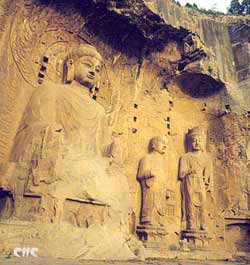Luoyang is located in the middle reaches of the Yellow River in the western part of Henan Province.
It was the capital of nine dynasties starting from around 770 B.C. The Chinese government has paid special attention to the protection of historic city, although its ancient sites have lost much of their original grandeur after so many changes in history.
Luoyang today is an important industrial city. Since 1953, more than a dozen large-size industrial enterprises have been established here; major products are tractors and bearings.
Luoyang is known as the "city of peonies," and the best time to visit it is in late spring when the peonies are in full bloom. It is said that Empress Wu Zetian (624-705) of the Tang Dynasty once decreed that all the flowers in her royal garden in the capital Chang'an (today's Xi'an) were to bloom in deep winter. The flowers, afraid of the power of the Empress, all bloomed, except for the peony. This enraged the empress, who ordered the peony degraded and moved to Luoyang. Since then, the plant flourished here.
Longmen Grottoes

Locate twelve kilometers south of Luoyang, the Longmen Grottoes are among the greatest treasure troves of ancient stone carving in China, together with Dunhuang in the northwestern province of Gansu and Yungang in the northern province of Shanxi.
The work on these grottoes began in 494 during the Northern Wei Dynasty and continued for more than four hundred years in the ensuing Sui and Tang dynasties. The grottoes are cut into precipitous cliffs on both banks of the Yishui River, and stretch for over a thousand meters from south to north. The existing 2,100 caves and niches contain more than 100,000 statues of Buddhist figures in various postures, the largest rising over seventeen meters and the smallest only two centimeters. There are also 3,600 inscribed tablets and forty pagodas here.
The stone sculptures at Longmen represent a new height on the art of stone carving and the development of Buddhism in China. The largest Buddhist monastery at Longmen, the Fengxian Temple, in particular, contains the most exquisite works of art among the grottoes and represents the best stone carving techniques of the Tang Dynasty Emperor Gao Zong (650-683) gave to his wife, Empress Wu Zetian for cosmetics.
Useful information
Admission Fee: RMB 60
Opening Hours: 07:10 to 17:30
Recommended Time for a Visit: Two hours
Bus Route: No.53, 60
Tel: 86-379-5980186 5980156
Click here to see local weather
Click here for reservation
White Horse Temple (Baimasi)
Located about twenty kilometers west of Luoyang and having a history of 1,900 years, this temple was the first Buddhist monastery ever built in China and is still inhabited by monks. During the Easter Han Dynasty (A.D. 25 -220), the emperor dispatched monks to India to obtain Buddhist scriptures; these were brought back to China on a white horse, in memory of which a monastery was built near Luoyang.
The White Horse Temple is a group of compactly arranged palaces, towers and halls surrounded by scarlet walls and covered with yellow glazed tiles with many stone tablets bearing calligraphic inscriptions. The most magnificent buildings in the temple include the Hall of Heavenly Kings, the Hall of Great Buddha, the Grand Hall, the Reception Hall (Jieyindian), the Clear and Cool Terrace (Qingliangtai), and the southeast is Matching Clouds Pagoda (Qiyunta), a square structure 24 meters high with thirteen levels.
Other interesting places to visit in Luoyang include the Guan Yu Grove (Guanlin) where General Guan Yu of the State of Shu during the Three Kingdoms Period was buried, the Western Han Tomb with murals inside the Imperial Palace Park, and ruins of Hanjia Granary built during the Sui Dynasty at the beginning of the sixth century.
(china.org.cn)
|

